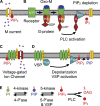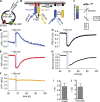Kinetics of PIP2 metabolism and KCNQ2/3 channel regulation studied with a voltage-sensitive phosphatase in living cells
- PMID: 20100891
- PMCID: PMC2812502
- DOI: 10.1085/jgp.200910345
Kinetics of PIP2 metabolism and KCNQ2/3 channel regulation studied with a voltage-sensitive phosphatase in living cells
Abstract
The signaling phosphoinositide phosphatidylinositol 4,5-bisphosphate (PIP(2)) is synthesized in two steps from phosphatidylinositol by lipid kinases. It then interacts with KCNQ channels and with pleckstrin homology (PH) domains among many other physiological protein targets. We measured and developed a quantitative description of these metabolic and protein interaction steps by perturbing the PIP(2) pool with a voltage-sensitive phosphatase (VSP). VSP can remove the 5-phosphate of PIP(2) with a time constant of tau <300 ms and fully inhibits KCNQ currents in a similar time. PIP(2) was then resynthesized from phosphatidylinositol 4-phosphate (PIP) quickly, tau = 11 s. In contrast, resynthesis of PIP(2) after activation of phospholipase C by muscarinic receptors took approximately 130 s. These kinetic experiments showed that (1) PIP(2) activation of KCNQ channels obeys a cooperative square law, (2) the PIP(2) residence time on channels is <10 ms and the exchange time on PH domains is similarly fast, and (3) the step synthesizing PIP(2) by PIP 5-kinase is fast and limited primarily by a step(s) that replenishes the pool of plasma membrane PI(4)P. We extend the kinetic model for signaling from M(1) muscarinic receptors, presented in our companion paper in this issue (Falkenburger et al. 2010. J. Gen. Physiol. doi:10.1085/jgp.200910344), with this new information on PIP(2) synthesis and KCNQ interaction.
Figures









Similar articles
-
Electrostatic interaction of internal Mg2+ with membrane PIP2 Seen with KCNQ K+ channels.J Gen Physiol. 2007 Sep;130(3):241-56. doi: 10.1085/jgp.200709821. J Gen Physiol. 2007. PMID: 17724161 Free PMC article.
-
Quantitative properties and receptor reserve of the DAG and PKC branch of G(q)-coupled receptor signaling.J Gen Physiol. 2013 May;141(5):537-55. doi: 10.1085/jgp.201210887. J Gen Physiol. 2013. PMID: 23630338 Free PMC article.
-
Affinity for phosphatidylinositol 4,5-bisphosphate determines muscarinic agonist sensitivity of Kv7 K+ channels.J Gen Physiol. 2009 Nov;134(5):437-48. doi: 10.1085/jgp.200910313. J Gen Physiol. 2009. PMID: 19858360 Free PMC article.
-
Regulation of neural KCNQ channels: signalling pathways, structural motifs and functional implications.J Physiol. 2008 Apr 1;586(7):1811-21. doi: 10.1113/jphysiol.2007.148304. Epub 2008 Jan 31. J Physiol. 2008. PMID: 18238808 Free PMC article. Review.
-
M current mystery messenger revealed?Neuron. 2002 Aug 1;35(3):411-2. doi: 10.1016/s0896-6273(02)00792-4. Neuron. 2002. PMID: 12165463 Review.
Cited by
-
Use of virtual cell in studies of cellular dynamics.Int Rev Cell Mol Biol. 2010;283:1-56. doi: 10.1016/S1937-6448(10)83001-1. Int Rev Cell Mol Biol. 2010. PMID: 20801417 Free PMC article. Review.
-
Biophysical physiology of phosphoinositide rapid dynamics and regulation in living cells.J Gen Physiol. 2022 Jun 6;154(6):e202113074. doi: 10.1085/jgp.202113074. Epub 2022 May 18. J Gen Physiol. 2022. PMID: 35583815 Free PMC article.
-
Design principles of PI(4,5)P2 clustering under protein-free conditions: Specific cation effects and calcium-potassium synergy.Proc Natl Acad Sci U S A. 2022 May 31;119(22):e2202647119. doi: 10.1073/pnas.2202647119. Epub 2022 May 23. Proc Natl Acad Sci U S A. 2022. PMID: 35605121 Free PMC article.
-
Phosphoinositides regulate ion channels.Biochim Biophys Acta. 2015 Jun;1851(6):844-56. doi: 10.1016/j.bbalip.2014.09.010. Epub 2014 Sep 18. Biochim Biophys Acta. 2015. PMID: 25241941 Free PMC article. Review.
-
Phosphatidylinositol 4,5-bisphosphate degradation inhibits the Na+/bicarbonate cotransporter NBCe1-B and -C variants expressed in Xenopus oocytes.J Physiol. 2015 Feb 1;593(3):541-58. doi: 10.1113/jphysiol.2014.284307. J Physiol. 2015. PMID: 25398525 Free PMC article.
References
-
- Balla A., Tuymetova G., Tsiomenko A., Várnai P., Balla T. 2005. A plasma membrane pool of phosphatidylinositol 4-phosphate is generated by phosphatidylinositol 4-kinase type-III alpha: studies with the PH domains of the oxysterol binding protein and FAPP1. Mol. Biol. Cell. 16:1282–1295 10.1091/mbc.E04-07-0578 - DOI - PMC - PubMed
Publication types
MeSH terms
Substances
Grants and funding
LinkOut - more resources
Full Text Sources
Other Literature Sources
Research Materials
Miscellaneous

